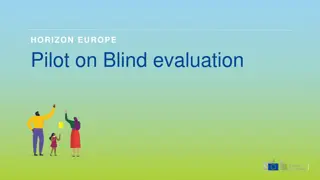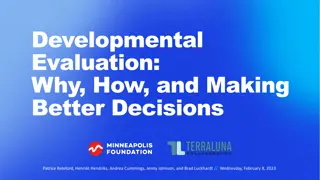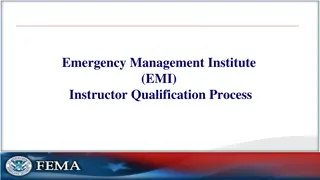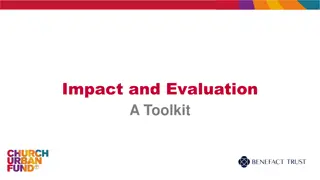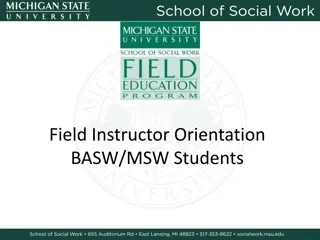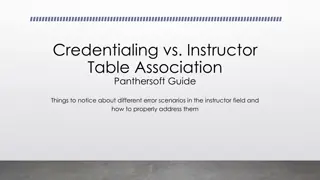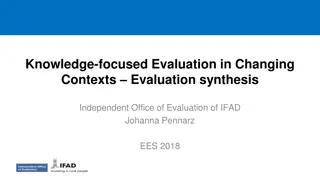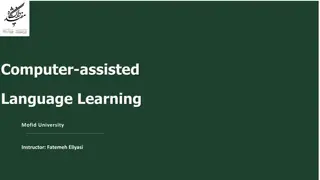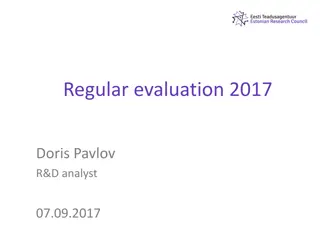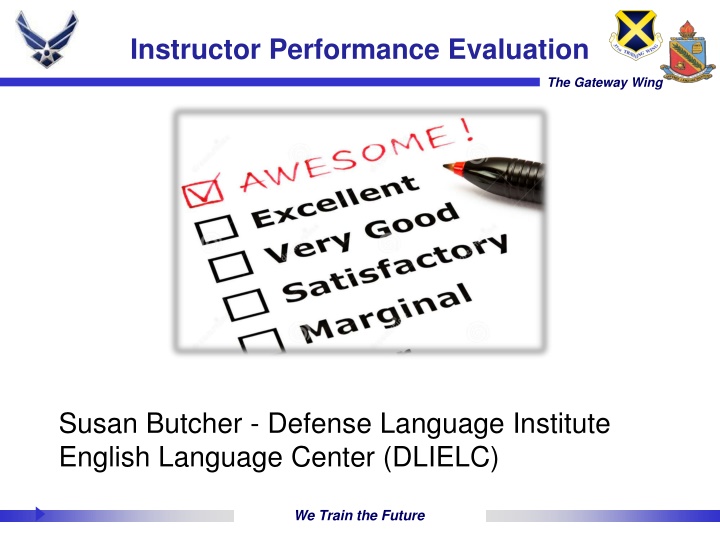
Performance Evaluation Process at DLIELC: Enhancing Instructor Efficiency
Explore the evolution of the performance evaluation process at DLIELC, including the formation of the Instructor Evaluation Working Group, the road to developing a comprehensive rubric, and significant changes implemented to streamline evaluations and enhance instructional quality.
Download Presentation

Please find below an Image/Link to download the presentation.
The content on the website is provided AS IS for your information and personal use only. It may not be sold, licensed, or shared on other websites without obtaining consent from the author. If you encounter any issues during the download, it is possible that the publisher has removed the file from their server.
You are allowed to download the files provided on this website for personal or commercial use, subject to the condition that they are used lawfully. All files are the property of their respective owners.
The content on the website is provided AS IS for your information and personal use only. It may not be sold, licensed, or shared on other websites without obtaining consent from the author.
E N D
Presentation Transcript
Instructor Performance Evaluation The Gateway Wing Susan Butcher - Defense Language Institute English Language Center (DLIELC) We Train the Future
Agenda The Gateway Wing FY 17 Overview of DLIELC Background of Instructor Evaluation 2016 formation of Instructor Evaluation Working Group (IEWG) Road to the Evaluation Rubric Evaluation process Rubric 2 We Train the Future
Overview of DLIELC FY 17 The Gateway Wing Trained 3,019 students from 116 countries, including 713 US Army students and ROTC cadets Graduation success rate: 96% Average daily load: 707 students in 3 different sections Peak number: 1,003 students (reached in May) Total # Instructors # assigned to classroom T : S ratio May Sept 204 195 138 104 1:5 1:7 3 We Train the Future
Background/History The Gateway Wing Replacing an evaluation format from the 1980s Core docs (job descriptions) have changed Several past initiatives to update evaluations Perceptions of subjectivity Time-consuming for supervisors Issues with unannounced observations 4 We Train the Future
Road to the Rubric The Gateway Wing Instructor Evaluation Working Group process: Researched industry best practices Defined a Fully Successful instructor as one who meets the rigorous core doc standards Examined core doc for observable classroom duties Surveyed supervisors for observation criteria Observed in AE/SE/GE classes Composed set of criteria for Evaluation Tested rubric in AE/SE/GE classes 5 We Train the Future
Participation The Gateway Wing Instructor Evaluation Working Group : 4 instructors / 2 supervisors / 2 chiefs representing all areas of instruction 72 people attended weekly information sessions 9 focus groups: 15 supervisors and 43 instructors 27 supervisors conducted 54 validation trials Created for teachers by teachers. 6 We Train the Future
Significant Changes The Gateway Wing Reduction in number of ratings from 5 to 3 Synthesis of 36 elements into 11 criteria Development of detailed descriptors and examples for each rating for all 11 criteria Addition of a post-observation conference Automation of parts of the process 7 We Train the Future
Why a rubric? The Gateway Wing It's essential that different individuals, using the same framework, can agree on the level of performance for what they observed . . . . -- Charlotte Danielson, expert in the design of teacher evaluation systems. 10 We Train the Future
The Rubric in Use The Gateway Wing Observation tool Evaluation tool Criterion-referenced instrument Professional development tool 11 We Train the Future
Rubric Criteria Example #1 The Gateway Wing Needs Improvement Instructor does not plan or coordinate necessary actions or appropriate resources to accomplish objectives; demonstrates incomplete understanding of materials, instructor guidance, activity procedures, or lesson objectives; applicable lesson plans, materials, supplies, equipment, technology, or examples are absent, inappropriate, or not ready to use; instructor's use of resources detracts from lesson effectiveness or wastes time Fully Successful Instructor plans and coordinates necessary actions and uses appropriate resources to accomplish objectives; demonstrates understanding of the lesson content and materials, instructor guidance, and activity procedures; has applicable lesson plans, materials, supplies, equipment, technology, and examples ready to use; use of resources and activities takes into account language skill level, time management, and student engagement Exemplary Instructor meets Fully Successful and plans and prepares additional actions, materials or resources that enhance lesson effectiveness; lesson enhancements highly engage students, increase communicative interaction, and/or address multiple skills or learning styles Planning, preparation, and use of Materials and Resources 1 Examples: Plans highly efficient use of resources and class time; adds, omits, or modifies activities to meet student needs; anticipates student questions and difficulties and provides additional support; plans for contingencies; incorporates real-world resources; plans activities that help students connect prior knowledge to lesson objectives; seamless transitions; uses educational technology effectively; resources and materials stimulate additional communication Examples: Has a clear plan for the lesson; focuses on lesson objectives; follows logical sequence of activities; transitions effectively; has handouts, supplies, notes, audio and/or videos ready; easily locates lesson components, resources and answers in the text; uses educational technology effectively; resources and materials add value and do not detract from the lesson Examples: Shows unfamiliarity with materials; does not target objectives; presents activities out of logical sequence; disorganization disrupts lesson, causes student confusion, or wastes time; does not have audio, video or handouts ready; uses inappropriate materials for student skill level or time management; overuses technology that distracts; does not provide sufficient visuals; has unclear or disorganized board work 12 We Train the Future
Fulfilling Core Doc Duties = Fully Successful The Gateway Wing 13 We Train the Future
Trends found in Exemplary The Gateway Wing 14 We Train the Future
What determines a rating? The Gateway Wing Sustained Major Significant Key Prevalent Predominant Central Consistent 15 We Train the Future
The Gateway Wing We all need people who will give us feedback. That s how we improve. -- Bill Gates 16 We Train the Future




